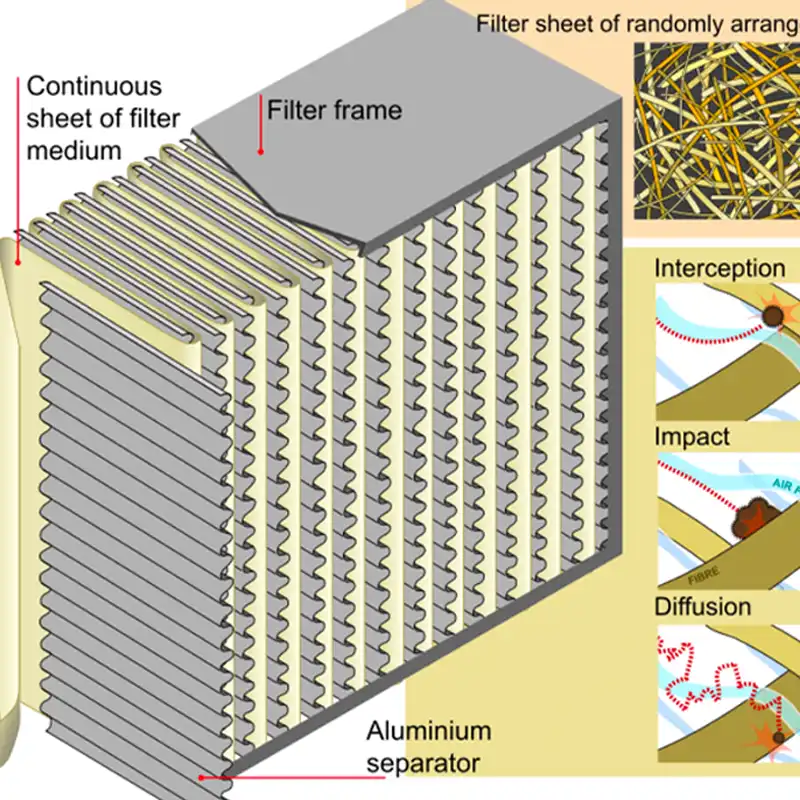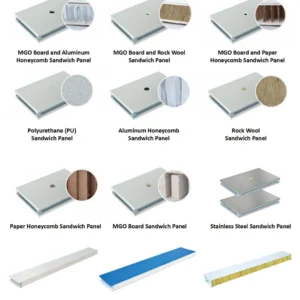In today’s fast-paced world, ensuring the quality of the air we breathe is paramount to maintaining good health. With the growing concerns over air pollution and allergens, HEPA filters have gained popularity as effective tools for purifying the air in homes and workplaces. But how does a HEPA filter work, and why is it so efficient at improving indoor air quality?
Let’s dive into the mechanics of these remarkable devices and understand how a HEPA filter works.
What Is HEPA Filter?
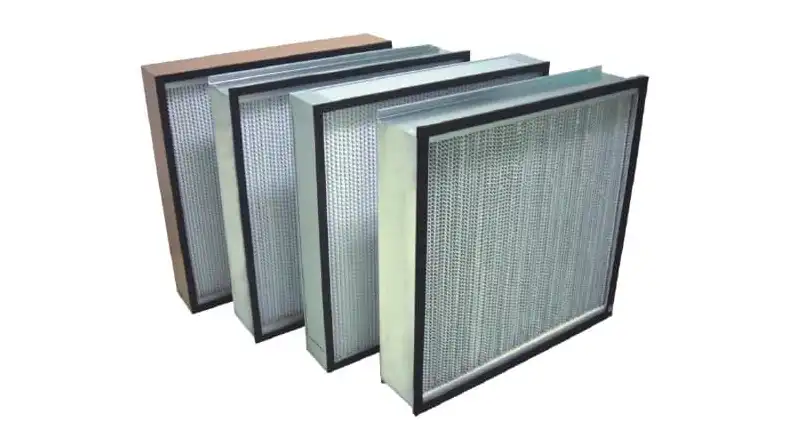
A HEPA filter, or High Efficiency Particulate Air filter, is a type of air filter designed to remove extremely small particles and contaminants from the air. These filters are known for their exceptional efficiency in capturing particles, including dust, pollen, pet dander, mold spores, bacteria, and even some viruses.
The key feature of a HEPA filter is its dense and intricate maze-like structure, typically made of fiberglass fibers. This structure allows the filter to trap particles as air flows through it, preventing them from reentering the environment. To be classified as a true HEPA filter, it must meet strict standards, capturing 99.97% of particles that are 0.3 microns or larger in size.
HEPA filters are commonly used in air purifiers, vacuum cleaners, and various industrial applications where maintaining clean air is essential. They are highly effective in improving indoor air quality and are especially beneficial for individuals with allergies, asthma, or anyone looking to breathe cleaner, healthier air.
How Does A Hepa Filter Work?
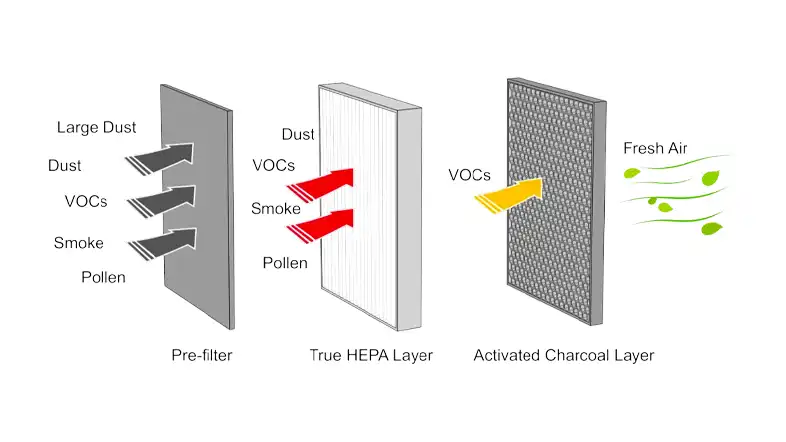
A HEPA filter, short for High Efficiency Particulate Air filter, operates on a simple but highly effective principle to clean and purify the air. Here’s a brief explanation of how a HEPA filter works:
Air Intake: The process begins when the contaminated air is drawn into the device containing the HEPA filter. This air often carries particles like dust, pollen, pet dander, smoke, and even tiny microorganisms.
Filtration Mechanism: Inside the HEPA filter, there is a dense mat of fibers, typically made of fiberglass, arranged in a haphazard pattern. These fibers create a maze-like structure that the air must pass through.
Particle Capture: As the air flows through this labyrinth of fibers, particles within the air collide with the fibers. The design of the filter is such that particles become trapped within this network of fibers due to various mechanisms like interception, impaction, and diffusion.
Size Matters: HEPA filters are renowned for their ability to capture extremely small particles. To qualify as a true HEPA filter, it must be able to trap 99.97% of particles that are 0.3 microns or larger in size. This includes a wide range of particles, from visible dust to microscopic bacteria and viruses.
Clean Air Output: After passing through the HEPA filter, the purified air is released back into the environment. The majority of the captured contaminants are now removed from the air, resulting in cleaner, healthier air to breathe.
In summary, a HEPA filter works by physically trapping particles within its dense fiber structure as air passes through. This efficient filtration process makes HEPA filters a popular choice for improving indoor air quality, reducing allergens, and creating a healthier living or working environment.
HEPA Filter Pore Size
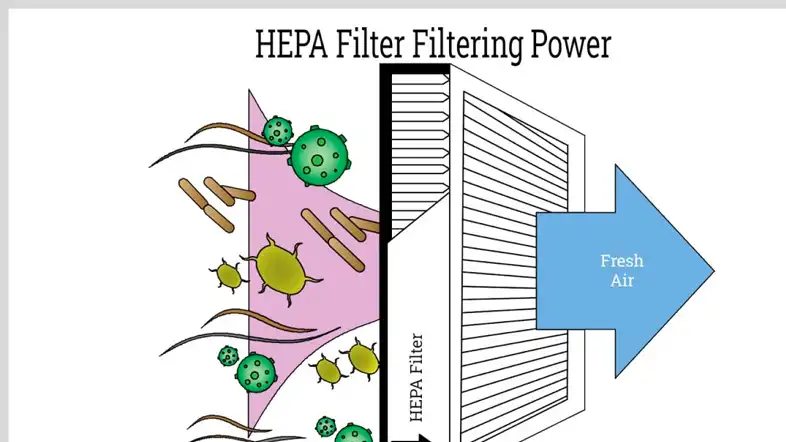
A HEPA (High Efficiency Particulate Air) filter is a type of air filter that is designed to remove very small particles from the air, including dust, pollen, pet dander, and even some bacteria and viruses. The effectiveness of a HEPA filter is often measured by its “pore size,” which refers to the size of the openings or gaps in the filter material through which air and particles must pass.
HEPA filters are known for their high filtration efficiency, which means they are capable of capturing a high percentage of particles that are a specific size or larger. The typical minimum efficiency of a HEPA filter is 99.97% for particles that are 0.3 micrometers (μm) in size.
However, it’s important to understand that HEPA filters are not just effective at capturing particles that are exactly 0.3 μm in size. They are actually highly efficient at capturing particles both larger and smaller than 0.3 μm. Here’s why:
- Mechanical Filtration: HEPA filters work through mechanical filtration, which means they physically trap particles as air passes through the filter. The size of the particles that can be trapped is largely determined by the size of the gaps or pores in the filter material.
- Particle Diffusion: Particles smaller than the filter’s pore size are captured through a process called diffusion. These smaller particles move in a zigzag pattern as they pass through the filter, increasing the likelihood of them colliding with and being trapped by the filter fibers.
- Electrostatic Attraction: Some HEPA filters also have an electrostatic charge that can attract and capture charged particles, further enhancing their efficiency.
So, while the nominal pore size of a HEPA filter is typically 0.3 μm, the filter is highly effective at capturing particles both larger and smaller than this size due to the mechanisms mentioned above. This is why HEPA filters are considered one of the most efficient types of air filters for improving indoor air quality and are often used in environments where clean air is critical, such as hospitals, laboratories, and cleanrooms.
Here’s a table summarizing HEPA filter pore sizes and their effectiveness in capturing particles of different sizes:
| Filter Pore Size (Nominal) | Particle Size Range Captured Effectively | Typical Efficiency |
|---|---|---|
| 0.3 micrometers (μm) | Particles around 0.3 μm in size, including some viruses, bacteria, and smaller particles | Approximately 99.97% |
| Smaller than 0.3 μm | Particles smaller than the nominal pore size are captured efficiently through diffusion and electrostatic attraction | Very high efficiency |
| Larger than 0.3 μm | Particles larger than the nominal pore size are captured effectively through mechanical filtration | Very high efficiency |
Please note that HEPA filters are highly efficient at capturing particles both larger and smaller than their nominal pore size, making them effective at improving indoor air quality by removing a wide range of contaminants from the air. The nominal pore size of 0.3 μm is used as a standard reference point for rating HEPA filter efficiency, but the filters perform exceptionally well outside of this specific range.
The Filtration Process
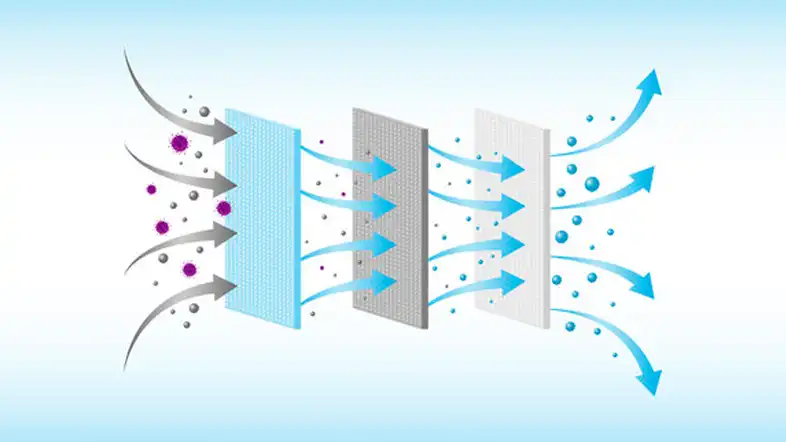
let’s break down the filtration process of a HEPA (High Efficiency Particulate Air) filter step by step:
Step 1: Airflow
The process begins with the circulation of air through the HEPA filter.
Air is drawn into the filter, typically by a fan or HVAC system, and moves through the filter in a specified direction.
Step 2: Filter Media
Inside the HEPA filter, you’ll find the filter media, a critical component.
The filter media is usually made of a dense, fine-fibered material like fiberglass.
This material is folded and pleated to create a large surface area within a compact filter.
Step 3: Mechanical Filtration
The primary mechanism of HEPA filtration is mechanical.
As air passes through the filter media, particles in the air are forced to change direction multiple times due to the convoluted pathway created by the pleats.
Larger particles cannot follow these twists and turns and collide with the fibers, becoming trapped.
Think of it like a car navigating a winding road; it can’t travel in a straight line.
Step 4: Diffusion
Smaller particles, those smaller than the gaps or pores in the filter media, are also effectively captured.
These smaller particles move erratically as they encounter air molecules, causing them to collide with and adhere to the filter fibers.
This phenomenon is called diffusion.
Step 5: Electrostatic Attraction (Optional)
Some HEPA filters are equipped with an electrostatic charge to enhance filtration efficiency.
The electrostatic charge attracts charged particles in the air, further increasing the filter’s ability to capture particles.
Step 6: Capture Efficiency
HEPA filters are highly efficient.
They have a minimum capture efficiency of 99.97% for particles as small as 0.3 micrometers (μm) in size.
This means that for every 10,000 particles of 0.3 μm size that enter the filter, only three are expected to pass through.
The efficiency is even higher for particles both larger and smaller than 0.3 μm.
Step 7: Clean Air Output
After passing through the HEPA filter, the air emerges on the other side significantly cleaner and free of the captured particles.
This purified air can then be recirculated into the room, providing improved indoor air quality.
Step 8: Regular Maintenance
It’s important to note that HEPA filters require regular maintenance.
Over time, the filter can become clogged with captured particles, reducing its effectiveness.
Regular replacement or cleaning of the filter is necessary to maintain optimal filtration efficiency.
In summary, the step-by-step process of a HEPA filter involves drawing air through a filter media that uses mechanical filtration, diffusion, and possibly electrostatic attraction to capture a wide range of airborne particles, resulting in cleaner and healthier indoor air. Regular maintenance is essential to keep the filter working efficiently.
The Advantages of HEPA Filters
Exceptional Particle Removal
HEPA filters excel in removing a wide range of particles, making them effective against allergens, pollutants, and even some bacteria and viruses. But how does a hepa filter work for covid specifically, and can it help in preventing the spread of viruses?
Asthma and Allergy Relief
For individuals with asthma or allergies, HEPA filters can provide substantial relief by removing airborne triggers like pollen and pet dander. But how a HEPA filter works to alleviate these symptoms?
Improved Indoor Air Quality
By consistently removing contaminants, HEPA filters contribute to a healthier indoor environment, reducing the risk of respiratory issues and other health problems. So, what is a hepa filter and how does it work to improve indoor air quality?
Conclusion
In conclusion, HEPA filters are a remarkable innovation that plays a vital role in improving indoor air quality. Their efficient filtration mechanism, small pore size, and certifications make them a go-to choice for those seeking cleaner air.
By incorporating a HEPA filter-equipped air purifier into your home or workplace, you can breathe easier, knowing that you’re taking a significant step towards cleaner and healthier air.
If you want to know more about HEPA filter how it works, please feel free to contact us any time. And don’t be hesitate to contact us at any time if you are looking for the HEPA filters.
FAQs
Are all HEPA filters the same?
No, not all HEPA filters are the same. It’s essential to look for certifications like “True HEPA” or “HEPA H13” to ensure the filter meets the required standards for efficiency.
Do HEPA filters remove odors?
HEPA filters primarily focus on capturing particles, but some air purifiers come with additional activated carbon filters to help remove odors.
How often should I replace my HEPA filter?
The frequency of replacement depends on the manufacturer’s recommendations and usage. Typically, HEPA filters should be replaced every 6-12 months.
Can HEPA filters remove cigarette smoke?
HEPA filters can capture some particles in cigarette smoke, but they may not eliminate all odors and chemicals associated with smoking. Additional filtration may be required.
Can HEPA filters help with COVID-19 prevention?
While HEPA filters can capture some viruses, they should not be solely relied upon for COVID-19 prevention. Proper ventilation, mask-wearing, and vaccination are also essential measures.

